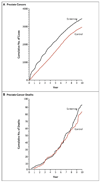Mortality results from a randomized prostate-cancer screening trial
- PMID: 19297565
- PMCID: PMC2944770
- DOI: 10.1056/NEJMoa0810696
Mortality results from a randomized prostate-cancer screening trial
Erratum in
- N Engl J Med. 2009 Apr 23;360(17):1797
Abstract
Background: The effect of screening with prostate-specific-antigen (PSA) testing and digital rectal examination on the rate of death from prostate cancer is unknown. This is the first report from the Prostate, Lung, Colorectal, and Ovarian (PLCO) Cancer Screening Trial on prostate-cancer mortality.
Methods: From 1993 through 2001, we randomly assigned 76,693 men at 10 U.S. study centers to receive either annual screening (38,343 subjects) or usual care as the control (38,350 subjects). Men in the screening group were offered annual PSA testing for 6 years and digital rectal examination for 4 years. The subjects and health care providers received the results and decided on the type of follow-up evaluation. Usual care sometimes included screening, as some organizations have recommended. The numbers of all cancers and deaths and causes of death were ascertained.
Results: In the screening group, rates of compliance were 85% for PSA testing and 86% for digital rectal examination. Rates of screening in the control group increased from 40% in the first year to 52% in the sixth year for PSA testing and ranged from 41 to 46% for digital rectal examination. After 7 years of follow-up, the incidence of prostate cancer per 10,000 person-years was 116 (2820 cancers) in the screening group and 95 (2322 cancers) in the control group (rate ratio, 1.22; 95% confidence interval [CI], 1.16 to 1.29). The incidence of death per 10,000 person-years was 2.0 (50 deaths) in the screening group and 1.7 (44 deaths) in the control group (rate ratio, 1.13; 95% CI, 0.75 to 1.70). The data at 10 years were 67% complete and consistent with these overall findings.
Conclusions: After 7 to 10 years of follow-up, the rate of death from prostate cancer was very low and did not differ significantly between the two study groups. (ClinicalTrials.gov number, NCT00002540.)
2009 Massachusetts Medical Society
Conflict of interest statement
No other potential conflict of interest relevant to this article was reported.
Figures
Comment in
-
Screening for prostate cancer--the controversy that refuses to die.N Engl J Med. 2009 Mar 26;360(13):1351-4. doi: 10.1056/NEJMe0901166. Epub 2009 Mar 18. N Engl J Med. 2009. PMID: 19297564 No abstract available.
-
ACP Journal Club. Annual screening for prostate cancer did not reduce mortality from prostate cancer.Ann Intern Med. 2009 Jun 16;150(12):JC6-4, JC6-5. doi: 10.7326/0003-4819-150-12-200906160-02004. Ann Intern Med. 2009. PMID: 19528549 No abstract available.
-
Prostate-cancer screening.N Engl J Med. 2009 Jul 9;361(2):202; author reply 204-5. doi: 10.1056/NEJMc090849. N Engl J Med. 2009. PMID: 19587348 No abstract available.
-
Prostate-cancer screening.N Engl J Med. 2009 Jul 9;361(2):202-3; author reply 204-6. N Engl J Med. 2009. PMID: 19593850 No abstract available.
-
Prostate-cancer screening.N Engl J Med. 2009 Jul 9;361(2):203; author reply 204-5. N Engl J Med. 2009. PMID: 19593851 No abstract available.
-
Prostate-cancer screening.N Engl J Med. 2009 Jul 9;361(2):203; author reply 204-5. N Engl J Med. 2009. PMID: 19593852 No abstract available.
-
Prostate-cancer screening.N Engl J Med. 2009 Jul 9;361(2):204; author reply 204-6. N Engl J Med. 2009. PMID: 19593854 No abstract available.
-
Annual screening for prostate cancer did not reduce mortality from prostate cancer.Evid Based Med. 2009 Aug;14(4):104-5. doi: 10.1136/ebm.14.4.104. Evid Based Med. 2009. PMID: 19648420 No abstract available.
-
Words of wisdom. Re: Mortality results from a randomized prostate- cancer screening Trial.Eur Urol. 2009 Jun;55(6):1481-2. doi: 10.1016/j.eururo.2009.03.085. Eur Urol. 2009. PMID: 19650215 No abstract available.
-
Words of wisdom. Re: Mortality results from a randomized prostate-cancer screening trial.Eur Urol. 2009 Oct;56(4):743-4. doi: 10.1016/j.eururo.2009.07.011. Eur Urol. 2009. PMID: 19995525 No abstract available.
-
Screening for cancer of the prostate: do we have an answer?Natl Med J India. 2009 Jul-Aug;22(4):184-7. Natl Med J India. 2009. PMID: 20120993 No abstract available.
-
[Regular PSA screening does not reduce prostate cancer mortality].Praxis (Bern 1994). 2010 Feb 3;99(3):195-6. doi: 10.1024/1661-8157/a000024. Praxis (Bern 1994). 2010. PMID: 20127641 German. No abstract available.
References
-
- Potosky AL, Miller BA, Albertsen PC, Kramer BS. The role of increasing detection in the rising incidence of prostate cancer. JAMA. 1995;273:548–552. - PubMed
-
- Lin K, Lipsitz R, Miller T, Janakiraman S. Benefits and harms of prostate-specific antigen screening for prostate cancer: an evidence update for the U.S. Preventive Services Task Force. Ann Intern Med. 2008;149:192–199. - PubMed
-
- American Urological Association (AUA) Prostate-specific antigen (PSA) best practice policy. Oncology (Williston Park) 2000;14:267–272. 277-8, 280 passim. - PubMed
-
- American Cancer Society guidelines for the early detection of cancer. [Accessed March 6, 2009]. at http://www.cancer.org/docroot/ped/content/ped_2_3x_acs_cancer_detection_....
-
- Kawachi MH, Bahnson RR, Barry M, et al. National Comprehensive Cancer Network clinical practice guidelines in oncology: prostate cancer early detection (v.2.2007) [Accessed March 6, 2009]. at http://www.nccn.org/professionals/physician_gls/PDF/prostate_detection.pdf. - PubMed
Publication types
MeSH terms
Substances
Associated data
Grants and funding
- N01 CN025515/CN/NCI NIH HHS/United States
- N01 CN025404/CN/NCI NIH HHS/United States
- N01 CN025516/CN/NCI NIH HHS/United States
- N01 CN025514/CN/NCI NIH HHS/United States
- UL1 RR024992/RR/NCRR NIH HHS/United States
- N01 CN025518/CN/NCI NIH HHS/United States
- N01 CN025512/CN/NCI NIH HHS/United States
- N01 CN075022/CN/NCI NIH HHS/United States
- N01 CN025476/CN/NCI NIH HHS/United States
- N01 CN025511/CN/NCI NIH HHS/United States
- N01 CN025522/CN/NCI NIH HHS/United States
- N01 CN025524/CN/NCI NIH HHS/United States
- N01 CN025513/CN/NCI NIH HHS/United States
LinkOut - more resources
Full Text Sources
Other Literature Sources
Medical
Research Materials
Miscellaneous

